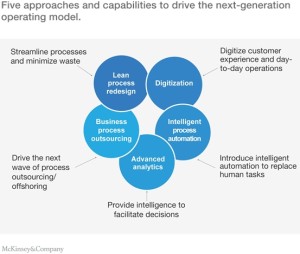Companies need to increase revenues, lower costs, and delight customers. Doing that requires reinventing the operating model.
Companies know where they want to go. They want to be more agile, quicker to react, and more effective. They want to deliver great customer experiences, take advantage of new technologies to cut costs, improve quality and transparency, and build value. The problem is that while most companies are trying to get better, the results tend to fall short: one-off initiatives in separate units that don’t have a big enterprise-wide impact; adoption of the improvement method of the day, which almost invariably yields disappointing results; and programs that provide temporary gains but aren’t sustainable.
We have found that for companies to build value and provide compelling customer experiences at lower cost, they need to commit to a next-generation operating model. This operating model is a new way of running the organization that combines digital technologies and operations capabilities in an integrated, well-sequenced way to achieve step-change improvements in revenue, customer experience, and cost.
A simple way to visualize this operating model is to think of it as having two parts, each requiring companies to adopt major changes in the way they work:
- The first part involves a shift from running uncoordinated efforts within siloes to launching an integrated operational-improvement program organized around customer journeys (the set of interactions a customer has with a company when making a purchase or receiving services) as well as the internal journeys (end-to-end processes inside the company). Examples of customer journeys include a homeowner filing an insurance claim, a cable-TV subscriber signing up for a premium channel, or a shopper looking to buy a gift online. Examples of internal-process journeys include Order-to-Cash or Record-to-Report.
- The second part is a shift from using individual technologies, operations capabilities, and approaches in a piecemeal manner inside siloes to applying them to journeys in combination and in the right sequence to achieve compound impact.
More: www.mckinsey.com/business
Authors: Albert Bollard is an associate partner in McKinsey’s New York office; Elixabete Larrea is an associate partner in the Boston office; Alex Singla is a senior partner in the Chicago office, and Rohit Sood is a partner in the Toronto office.
